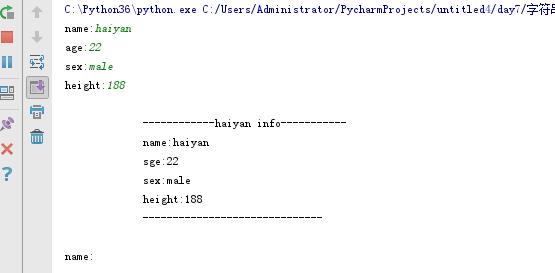字符串格式化及字符串的一些方法
Posted 功不是凭梦想和希望,而是凭 努力和实践。
tags:
篇首语:本文由小常识网(cha138.com)小编为大家整理,主要介绍了字符串格式化及字符串的一些方法相关的知识,希望对你有一定的参考价值。
1.%s,%d
举例1:name=\'egon\'
age=20
print("my name is %s my age is %s" %(name,age))#%s既能接受字符串,也能接受数字
print(‘my name is %s my age is %d’ %(name,age))#%d只能接受数字
举例2:用户信息的显示
1 while True: 2 name=input("name:") 3 age=input("age:") 4 sex=input("sex:") 5 height=input("height:") 6 msg=\'\'\' 7 ------------%s info----------- 8 name:%s 9 age:%s 10 sex:%s 11 height:%s 12 ------------------------------ 13 \'\'\'%(name,name,age,sex,heigth) 14 print(msg)
运行结果如下:

2.字符串方法

# name=\'egon\' #name=str(\'egon\')
# print(type(name))
#优先掌握
#1.移除空白strip
# msg=\' hello \'
# print(msg)
# print(msg.strip())
# 移除‘*’
# msg=\'***hello*********\'
# msg=msg.strip(\'*\')
# print(msg)
#移除左边的
# print(msg.lstrip(\'*\'))
#移除右边的
# print(msg.rstrip(\'*\'))
#用处
while True:
name=input(\'user: \').strip()
password=input(\'password: \').strip()
if name == \'egon\' and password == \'123\':
print(\'login successfull\')
#切分split
# info=\'root:x:0:0::/root:/bin/bash\'
# print(info[0]+info[1]+info[2]+info[3])
# user_l=info.split(\':\')
# print(user_l[0])
# msg=\'hello world egon say hahah\'
# print(msg.split()) #默认以空格作为分隔符
#cmd=\'download|xhp.mov|3000\'
# cmd_l=cmd.split(\'|\')
# print(cmd_l[1])
# print(cmd_l[0])
# print(cmd.split(\'|\',1))
#用处
while True:
cmd=input(\'>>: \').strip()
if len(cmd) == 0:continue
cmd_l=cmd.split()
print(\'命令是:%s 命令的参数是:%s\' %(cmd_l[0],cmd_l[1]))
#长度len
# print(len(\'hell 123\'))
#索引
# 切片:切出子字符串
# msg=\'hello world\'
# print(msg[1:3]) #1 2
# print(msg[1:4]) #1 2 3
# 掌握部分
oldboy_age=84
while True:
age=input(\'>>: \').strip()
if len(age) == 0:
continue
if age.isdigit():
age=int(age)
else:
print(\'must be int\')
#startswith,endswith
# name=\'alex_SB\'
# print(name.endswith(\'SB\'))
# print(name.startswith(\'alex\'))
#replace
# name=\'alex say :i have one tesla,my name is alex\'
# print(name.replace(\'alex\',\'SB\',1))
# print(\'my name is %s my age is %s my sex is %s\' %(\'egon\',18,\'male\'))
# print(\'my name is {} my age is {} my sex is {}\'.format(\'egon\',18,\'male\'))
# print(\'my name is {0} my age is {1} my sex is {0}:
{2}\'.format(\'egon\',18,\'male\'))
# print(\'my name is {name} my age is {age} my sex is {sex}\'.format(
# sex=\'male\',
# age=18,
# name=\'egon\'))
# name=\'goee say hello\'
# # print(name.find(\'S\',1,3)) #顾头不顾尾,找不到则返回-1不会报错,找到了则显示索引
# # print(name.index(\'S\')) #同上,但是找不到会报错
#
# print(name.count(\'S\',1,5)) #顾头不顾尾,如果不指定范围则查找所有
#join
# info=\'root:x:0:0::/root:/bin/bash\'
# print(info.split(\':\'))
# l=[\'root\', \'x\', \'0\', \'0\', \'\', \'/root\', \'/bin/bash\']
# print(\':\'.join(l))
#lower,upper
# name=\'eGon\'
# print(name.lower())
# print(name.upper())
#了解部分
#expandtabs
# name=\'egon\\thello\'
# print(name)
# print(name.expandtabs(1))
#center,ljust,rjust,zfill
# name=\'egon\'
# # print(name.center(30,\'-\'))
# print(name.ljust(30,\'*\'))
# print(name.rjust(30,\'*\'))
# print(name.zfill(50)) #用0填充
#captalize,swapcase,title
# name=\'eGon\'
# print(name.capitalize()) #首字母大写,其余部分小写
# print(name.swapcase()) #大小写翻转
# msg=\'egon say hi\'
# print(msg.title()) #每个单词的首字母大写
#在python3中
num0=\'4\'
num1=b\'4\' #bytes
num2=u\'4\' #unicode,python3中无需加u就是unicode
num3=\'四\' #中文数字
num4=\'Ⅳ\' #罗马数字
#isdigt:str,bytes,unicode
# print(num0.isdigit())
# print(num1.isdigit())
# print(num2.isdigit())
# print(num3.isdigit())
# print(num4.isdigit())
#isdecimal:str,unicode
# num0=\'4\'
# num1=b\'4\' #bytes
# num2=u\'4\' #unicode,python3中无需加u就是unicode
# num3=\'四\' #中文数字
# num4=\'Ⅳ\' #罗马数字
# print(num0.isdecimal())
# # print(num1.)
# print(num2.isdecimal())
# print(num3.isdecimal())
# print(num4.isdecimal())
#isnumeric:str,unicode,中文,罗马
# num0=\'4\'
# num1=b\'4\' #bytes
# num2=u\'4\' #unicode,python3中无需加u就是unicode
# num3=\'四\' #中文数字
# num4=\'Ⅳ\' #罗马数字
#
# print(num0.isnumeric())
# # print(num1)
# print(num2.isnumeric())
# print(num3.isnumeric())
# print(num4.isnumeric())
#is其他
# name=\'egon123\'
# print(name.isalnum()) #字符串由字母和数字组成
# name=\'asdfasdfa sdf\'
# print(name.isalpha()) #字符串只由字母组成
#
# name=\'asdfor123\'
# print(name.isidentifier())
name=\'egGon\'
print(name.islower())
# print(name.isupper())
# print(name.isspace())
name=\'Egon say\'
print(name.istitle())
以上是关于字符串格式化及字符串的一些方法的主要内容,如果未能解决你的问题,请参考以下文章